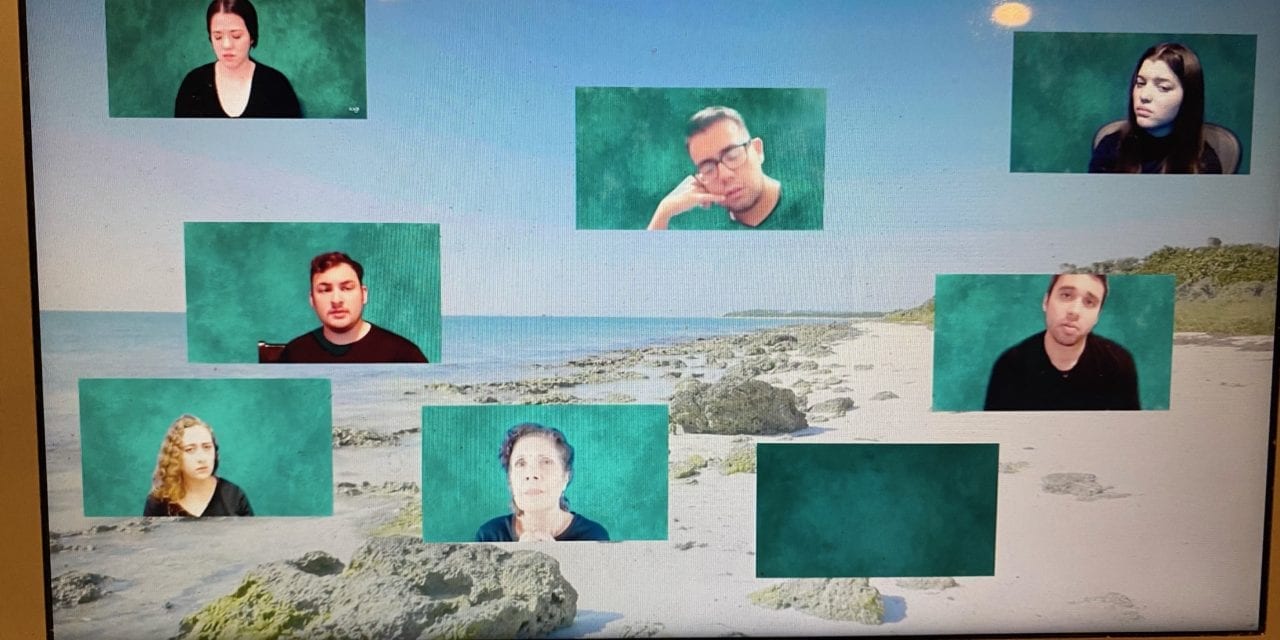PROVO — Brigham Young University’s staging of Manual for a Desperate Crossing and Letters from Cuba is the most innovative production I have ever seen. With a striking, timely message and an amazing digital production, it is a wonder of 2020 theater.

Show closes November 21, 2020.
The two one-act plays were written by María Irene Fornés, a Cuban immigrant to the United States. Describing the plays is a challenge; the theater department’s write-up describes her style as “avant-garde” at least four times, and it certainly is. “Something about her work has always been seen as too difficult for mainstream audiences,” dramaturg Angela Moser opines.
Letters tells two parallel stories happening simultaneously in Cuba and New York City. The action flits between the two, usually featuring the dialogue of two characters. Instead of speaking sequentially, the actors often speak non sequiturs (even within scene), almost like a language collage. Some of the character pairs include two roommates talking about girls, a father arguing with his sons, and a soldier in Castro fatigues discussing fleeing the country. While it was difficult for me to understand Letters from Cuba, it did contain a lovely declaration that “The greatest gift we can have is to have satisfaction with the life we have.”
Manual for a Desperate Crossing had a clearer storyline. It involved seven Cubans building a boat and sailing to Key West to escape the Communist regime. In addition to videos of the actors, the screen showed diagrams of how Cuban refugees create makeshift boats out of old cars. One of the most visually arresting scenes was the actors working together constructing the ship. When they hummed in unison, it was powerful. And as anyone who’s experienced the absurdity that is video conferencing can attest, I cannot fathom how they were able to pull off such synchronicity.
The plays are Spanish and English in about equal measure. Many times, the same sentences are translated immediately afterwards by the same character. While effective and ensuring that the audience understands more of the production, hearing phrases twice so frequently was unrealistic and often pulled me out of the moment. If only there could be subtitles like movies and opera, I suppose the flow of the plays would have been smoother. Another thing linguistic characteristic was the playwright’s choice to translate Spanish to English literally instead of into a more natural syntax. This resulted in awkward sentences like “A helicopter appears!” and “Thirst! Thirst! The throat is dry!” I commend the actors for tackling this awkward language. However, I think the plays would paint a more authentic, sympathetic portrait of Cuban immigrants with more realistic English dialogue. It is possible to be just as accurate and still let them talk naturally.

A cast member of Manual for a Desperate Crossing and Letters from Cuba rehearses at home.
The staging of both plays was unique and adapted for the circumstances of the coronavirus pandemic. All actors performed separately, at home, in front of a green or a blue screen. Their live, Zoom-style videochat windows were then brought together side by side, or sometimes separated on the same digital screen. The performance was streamed live on BYU’s website, with nothing recorded ahead of time. I marvel at how well it all worked. There were no lags, no technical problems. While the performances were certainly more stilted than they would be otherwise, I have seen a lot worse on college stages when actors weren’t separated by miles. In fact, much of the evening had already passed before I realized that the actors were not in the same room.
The staging wasn’t just a typical Brady Bunch style block of boxes, either. The video conference rectangles moved around the screen, sometimes they even combined and distorted. It was an amazing effect, and scenic and projection designers Elisabeth Goulding and Erin Bjorn and project engineer Taylor Glad worked together to create an innovative, commendable online theatrical experience.
I like that the actors, many of whom are second generation immigrants with English as a primary language, did not feign Hispanic accents. All things considered (and since actors weren’t even in the same room, there are a lot of things to consider!), their performances were tremendous. In particular, I was riveted by the tangible realism of Maria Angelica Sanchez-Carr, herself a Cuban immigrant. She melted completely into character, and gave a pair of praiseworthy, authentic performances. Otherwise, some of the performances felt large for the space, which was basically akin to live television close-ups.
A talkback afterwards held via Zoom video conferencing shed light on the cast’s performances. I learned that the synchronous, natural interactions depended partially on a gaming software called OBS. But it required more than technology for these plays to work. One actor explained that she had to pretend that her crockpot across the room was her co-actor. Amazing.
I commend everyone involved in this innovative and distinctly 2020 production. With the worldwide refugee crises of the past five years, immigration and race are important topics that theatre is well equipped to explore. In the program notes, director Kris Peterson (who is originally from Costa Rica) says this production is a direct response to the recent call of Russell M. Nelson, president of the school’s managing institution, the Church of Jesus of Latter-day Saints, to “abandon all attitudes and actions of prejudice.” Theatre is a valuable venue to explore these issues, and I applaud BYU’s theater department and all involved in this production in doing so, especially in such innovative ways. And in a pandemic, no less.





